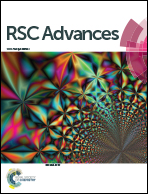Evolution of the reaction mechanism during the MTH induction period over the 2-dimensional FER zeolite†
Abstract
The methanol conversion reaction mechanism over HZSM-35, an ferrierite (FER)-type zeolite with 2-D channel intersections, was investigated during the induction period. The MTH induction period could be obviously shortened by co-feeding toluene or precoking the catalyst and the formation of tetramethylcyclopentenyl cation (tetraMCP+) during the induction period was also confirmed through 13C magic angle spinning (MAS) NMR and GC-MS experiments, suggesting the active role of aromatics. Moreover, the dual-cycle mechanism was evidently found to evolve as the induction reaction progressed. In the early stage, both the aromatic- and olefin-based routes work efficiently and pentamethylbenzene (pentaMB) was identified as the main aromatic hydrocarbon pool (HCP) species. While in the latter stage of the induction period, the olefin-based route turned out to be more dominant and pentaMB as well as hexamethylbenzene (hexaMB) became the main aromatic HCP species. Despite the limited space of the channel intersections, the reactivity of aromatics with larger molecular sizes like 1-ethyl-2,3,4,5,6-pentamethylbenzene (1-E-pentaMB) and hexaMB were much higher than lower methylbenzenes which indicates that the aromatic-based cycle can also proceed on the external acid sites of the HZSM-35 catalyst.


 Please wait while we load your content...
Please wait while we load your content...